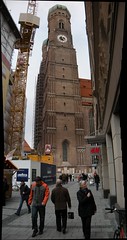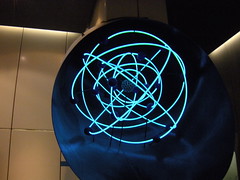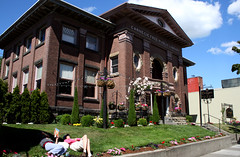 On Monday in Germany we went to Marienplatz and wandered around
the Christmas Market, some of the stores, had drinks in a little pub, visited the Toy Museum, and checked out an impressive looking church. We accidentally drew in some other tourists as we stood
gaping at the Glockenspiel tower waiting for the little show to begin at the wrong hour. That night Megan and Oliver came by our hotel and took us out to a traditional Bavarian restaurant and
brewery that had been brewing beer there for hundreds of years. It was fun although we may have kept Megan and Oliver out too late on a weeknight.
On Monday in Germany we went to Marienplatz and wandered around
the Christmas Market, some of the stores, had drinks in a little pub, visited the Toy Museum, and checked out an impressive looking church. We accidentally drew in some other tourists as we stood
gaping at the Glockenspiel tower waiting for the little show to begin at the wrong hour. That night Megan and Oliver came by our hotel and took us out to a traditional Bavarian restaurant and
brewery that had been brewing beer there for hundreds of years. It was fun although we may have kept Megan and Oliver out too late on a weeknight.
 The next day we went to the Deutsches Museum the largest science and technology museum in the world. And indeed it is very large, six floors
on a large grounds. I needed to better pace myself: I spent too much energy being interested in the engineering sections with steam engines, mining, aerospace etc. I was completely worn out by the
time we got to physics, chemistry, etc. etc. and we didn't even look in the natural sciences section. Anyway, its very large. That night we ate with Jon at an Italian restaurant. During the meal
two period dressed children came in and began singing then tried to shake down their captive audience in the restaurant asking for money. The man at the table next to us asked one of the children
what charity the money was going towards, the child said they kept the money, and the man said never mind then and sent the child away.
The next day we went to the Deutsches Museum the largest science and technology museum in the world. And indeed it is very large, six floors
on a large grounds. I needed to better pace myself: I spent too much energy being interested in the engineering sections with steam engines, mining, aerospace etc. I was completely worn out by the
time we got to physics, chemistry, etc. etc. and we didn't even look in the natural sciences section. Anyway, its very large. That night we ate with Jon at an Italian restaurant. During the meal
two period dressed children came in and began singing then tried to shake down their captive audience in the restaurant asking for money. The man at the table next to us asked one of the children
what charity the money was going towards, the child said they kept the money, and the man said never mind then and sent the child away.
Windows allows for application protocols in which, through the registry, you specify a URL scheme and a command line to have that URL passed to your application. Its an easy way to hook a webbrowser up to your application. Anyone can read the doc above and then walk through the registry and pick out the application protocols but just from that info you can't tell what the application expects these URLs to look like. I did a bit of research on some of the application protocols I've seen which is listed below. Good places to look for information on URI schemes: Wikipedia URI scheme, and ESW Wiki UriSchemes.
| Scheme | Name | Notes |
|---|---|---|
| search-ms | Windows Search Protocol |
The search-ms application protocol is a convention for querying the Windows Search index. The protocol enables applications, like Microsoft Windows Explorer, to query the index with
parameter-value arguments, including property arguments, previously saved searches, Advanced Query Syntax, Natural Query Syntax, and language code identifiers (LCIDs) for both the Indexer and
the query itself. See the MSDN docs for search-ms for more info. Example: search-ms:query=food |
| Explorer.AssocProtocol.search-ms | ||
| OneNote | OneNote Protocol |
From the OneNote help: /hyperlink "pagetarget" - Starts OneNote and opens the page specified by the pagetarget parameter. To obtain the hyperlink for any page in a OneNote
notebook, right-click its page tab and then click Copy Hyperlink to this Page.Example: onenote:///\\GUMMO\Users\davris\Documents\OneNote%20Notebooks\OneNote%202007%20Guide\Getting%20Started%20with%20OneNote.one#section-id={692F45F5-A42A-415B-8C0D-39A10E88A30F}&end |
| callto | Callto Protocol |
ESW Wiki Info on callto Skype callto info NetMeeting callto info Example: callto://+12125551234 |
| itpc | iTunes Podcast |
Tells iTunes to subscribe to an indicated podcast. iTunes documentation. C:\Program Files\iTunes\iTunes.exe /url "%1" Example: itpc:http://www.npr.org/rss/podcast.php?id=35 |
| iTunes.AssocProtocol.itpc | ||
| pcast | ||
| iTunes.AssocProtocol.pcast | ||
| Magnet | Magnet URI | Magnet URL scheme described by Wikipedia. Magnet URLs identify a resource by a hash of that resource so that when used in P2P scenarios no central authority is necessary to create URIs for a resource. |
| mailto | Mail Protocol |
RFC 2368 - Mailto URL Scheme. Mailto Syntax Opens mail programs with new message with some parameters filled in, such as the to, from, subject, and body. Example: mailto:?to=david.risney@gmail.com&subject=test&body=Test of mailto syntax |
| WindowsMail.Url.Mailto | ||
| MMS | mms Protocol |
MSDN describes associated protocols. Wikipedia describes MMS. "C:\Program Files\Windows Media Player\wmplayer.exe" "%L" Also appears to be related to MMS cellphone messages: MMS IETF Draft. |
| WMP11.AssocProtocol.MMS | ||
| secondlife | [SecondLife] |
Opens SecondLife to the specified location, user, etc. SecondLife Wiki description of the URL scheme. "C:\Program Files\SecondLife\SecondLife.exe" -set SystemLanguage en-us -url "%1" Example: secondlife://ahern/128/128/128 |
| skype | Skype Protocol |
Open Skype to call a user or phone number. Skype's documentation Wikipedia summary of skype URL scheme "C:\Program Files\Skype\Phone\Skype.exe" "/uri:%l" Example: skype:+14035551111?call |
| skype-plugin | Skype Plugin Protocol Handler |
Something to do with adding plugins to skype? Maybe. "C:\Program Files\Skype\Plugin Manager\skypePM.exe" "/uri:%1" |
| svn | SVN Protocol |
Opens TortoiseSVN to browse the repository URL specified in the URL. C:\Program Files\TortoiseSVN\bin\TortoiseProc.exe /command:repobrowser /path:"%1" |
| svn+ssh | ||
| tsvn | ||
| webcal | Webcal Protocol |
Wikipedia describes webcal URL scheme. Webcal URL scheme description. A URL that starts with webcal:// points to an Internet location that contains a calendar in iCalendar format. "C:\Program Files\Windows Calendar\wincal.exe" /webcal "%1" Example: webcal://www.lightstalkers.org/LS.ics |
| WindowsCalendar.UrlWebcal.1 | ||
| zune | Zune Protocol |
Provides access to some Zune operations such as podcast subscription (via Zune Insider). "c:\Program Files\Zune\Zune.exe" -link:"%1" Example: zune://subscribe/?name=http://feeds.feedburner.com/wallstrip. |
| feed | Outlook Add RSS Feed |
Identify a resource that is a feed such as Atom or RSS. Implemented by Outlook to add the indicated feed to Outlook. Feed URI scheme pre-draft document "C:\PROGRA~2\MICROS~1\Office12\OUTLOOK.EXE" /share "%1" |
| im | IM Protocol |
RFC 3860 IM URI scheme description Like mailto but for instant messaging clients. Registered by Office Communicator but I was unable to get it to work as described in RFC 3860. "C:\Program Files (x86)\Microsoft Office Communicator\Communicator.exe" "%1" |
| tel | Tel Protocol |
RFC 5341 - tel URI scheme IANA assignment RFC 3966 - tel URI scheme description Call phone numbers via the tel URI scheme. Implemented by Office Communicator. "C:\Program Files (x86)\Microsoft Office Communicator\Communicator.exe" "%1" |
Last Thursday I saw a bunch of college friends that I hadn't seen in a while, despite all of us working at Microsoft, and Saul and Ciera who were visiting. We had dinner at Typhoon! which I haven't been to in quite a while. Daniil and Val brought their cute child. I got to see Charlie and Matt who I'm not sure I've seen since my 25th birthday. There was much nerdiness. I need to remember to organize such a night myself sometime in near future so I don't have to wait another year to see them.
 On the weekend Sarah and I went out to dinner at Carnegie's, a former
public library in Ballard, Seattle that's now a restaurant. I saw the restaurant's website in Matt's delicious links and thought it looked interesting. The exterior and entryway look like a public
library, but just inside its redone as a sort of modern version of french classical with a bar and two dining rooms. No pictures since my replacement camera only arrived today, but there are
photos available. They serve french cuisine which was good and
not as expensive as I would have expected. An interesting place, although its a bit of a drive and I'm not sure if we'll be going back soon.
On the weekend Sarah and I went out to dinner at Carnegie's, a former
public library in Ballard, Seattle that's now a restaurant. I saw the restaurant's website in Matt's delicious links and thought it looked interesting. The exterior and entryway look like a public
library, but just inside its redone as a sort of modern version of french classical with a bar and two dining rooms. No pictures since my replacement camera only arrived today, but there are
photos available. They serve french cuisine which was good and
not as expensive as I would have expected. An interesting place, although its a bit of a drive and I'm not sure if we'll be going back soon.
Sarah asked me if I knew of a syntax highlighter for the QuickBase formula language which she uses at work. I couldn't find one but thought it might be fun to make a QuickBase Formula syntax highlighter based on the QuickBase help's description of the formula syntax. Thankfully the language is relatively simple since my skills with ANTLR, the parser generator, are rusty now and I've only used it previously for personal projects (like Javaish, the ridiculous Java based shell idea I had).
With the help of some great ANTLR examples and an ANTLR cheat sheet I was able to come up with the grammar that parses the QuickBase Formula syntax and prints out the same formula marked up with HTML SPAN tags and various CSS classes. ANTLR produces the parser in Java which I wrapped up in an applet, put in a jar, and embedded in an HTML page. The script in that page runs user input through the applet's parser and sticks the output at the bottom of the page with appropriate CSS rules to highlight and print the formula in a pretty fashion.
What I learned:
As noted previously, my page consists of the aggregation of my various feeds and in working on that code recently it was again brought to my attention that everyone has different ways of representing tag metadata in feeds. I made up a list of how my various feed sources represent tags and list that data here so that it might help others in the future.
| Source | Feed Type | Tag Markup Scheme | One Tag Per Element | Tag Scheme URI | Human / Machine Names | Example Markup |
|---|---|---|---|---|---|---|
| LiveJournal | Atom | atom:category | yes | no | no | , (source) |
| LiveJournal | RSS 2.0 | rss2:category | yes | no | no |
technical(soure) |
| WordPress | RSS 2.0 | rss2:category | yes | no | no |
, (source)
|
| Delicious | RSS 1.0 | dc:subject | no | no | no |
photosynth photos 3d tool(source) |
| Delicious | RSS 2.0 | rss2:category | yes | yes | no |
domain="http://delicious.com/SequelGuy/">(source) |
| Flickr | Atom | atom:category | yes | yes | no |
term="seattle"(source) |
| Flickr | RSS 2.0 | media:category | no | yes | no |
scheme="urn:flickr:tags">(source) |
| YouTube | RSS 2.0 | media:category | no | no | no |
label="Tags">(source) |
| LibraryThing | RSS 2.0 | No explicit tag metadata. | no | no | no | n/a, (source) |
| Tag Markup Scheme | Notes | Example |
|---|---|---|
|
Atom Category atom:category xmlns:atom="http://www.w3.org/2005/Atom"
|
|
term="catName"
|
|
RSS 2.0 category rss2:category empty namespace |
|
domain="tag:deletethis.net,2008:tagscheme">
|
|
Yahoo Media RSS Module category media:category xmlns:media="http://search.yahoo.com/mrss/"
|
|
scheme="http://dmoz.org"
|
|
Dublin Core subject dc:subject xmlns:dc="http://purl.org/dc/elements/1.1/"
|
|
humor
|
Update 2009-9-14: Added WordPress to the Tag Markup table and namespaces to the Tag Markup Scheme table.
In my Intro to Algorithms course in college the Fibonacci sequence was used as the example algorithm to which various types of algorithm creation methods were applied. As the course went on we made
better and better performing algorithms to find the nth Fibonacci number. In another course we were told about a matrix that when multiplied successively produced Fibonacci numbers. In my linear
algebra courses I realized I could diagonalize the matrix to find a non-recursive Fibonacci function. To my surprise this worked and I
found a function.

Looking online I found that of course this same function was already well known. Mostly I was irritated that after all the
algorithms we created for faster and faster Fibonacci functions we were never told about a constant time function like this.
I recently found my paper depicting this and thought it would be a good thing to use to try out MathML, a markup language for displaying math. I went to the MathML implementations page and installed a plugin for IE to display MathML and then began writing up my paper in MathML. I wrote the MathML by hand and must say that's not how its intended to be created. The language is very verbose and it took me a long time to get the page of equations transcribed.
MathML has presentation elements and content elements that can be used separately or together. I stuck to content elements and while it looked great in IE with my extension when I tried it in FireFox which has builtin MathML support it didn't render. As it turns out FireFox doesn't support MathML content elements. I had already finished creating this page by hand and wasn't about to switch to content elements. Also, in order to get IE to render a MathML document, the document needs directives at the top for specific IE extensions which is a pain. Thankfully, the W3C has a MathML cross platform stylesheet. You just include this XSL at the top of your XHTML page and it turns content elements into appropriate presentation elements, and inserts all the known IE extension goo required for you. So now my page can look lovely and all the ickiness to get it to render is contained in the W3C's XSL.